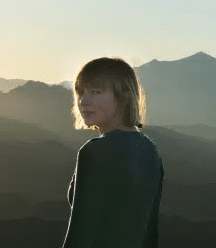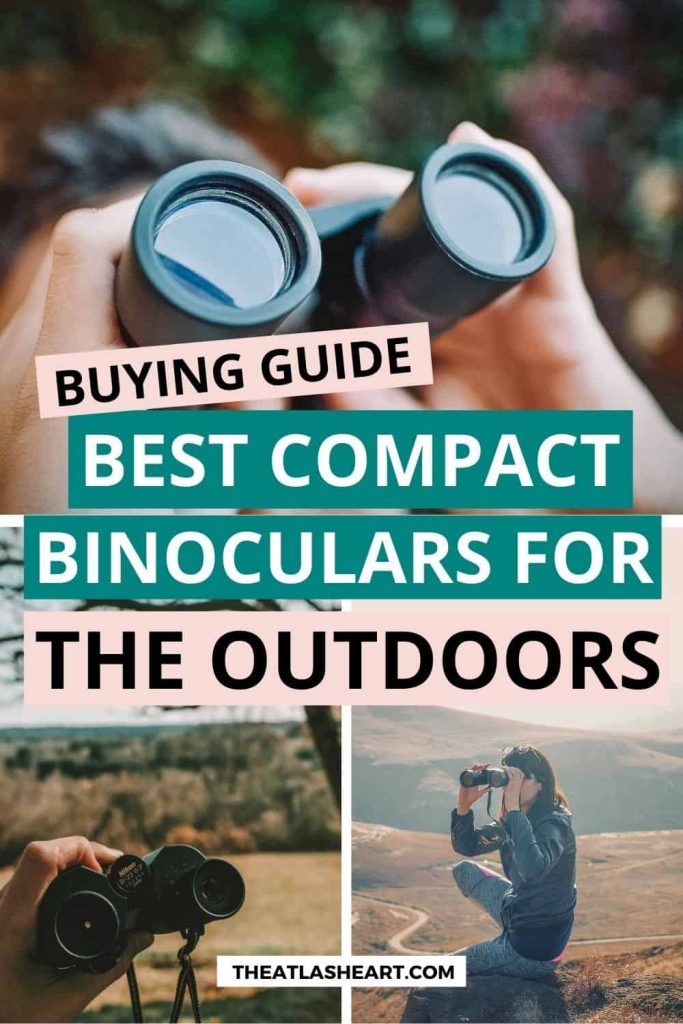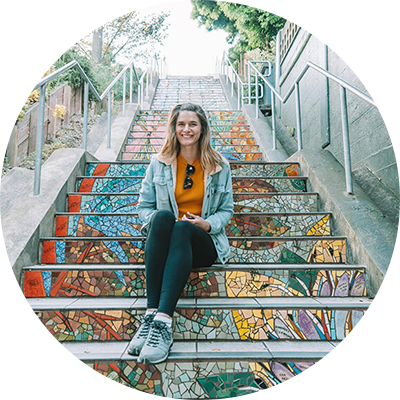TL;DR: The best compact binoculars are the Zeiss Terra, which offer high image quality, 88% light transmission, an objective lens of 25mm, and 8x magnification, all in a sleek and portable design with a large field of view. They lack fog proofing, but that doesn’t seem to be an issue.
If you’ve never brought along a good pair of binoculars on a hike or a trip, you’re missing out.
The outdoors is full of beautiful details you can’t always appreciate with the naked eye – from whale watching to birding.
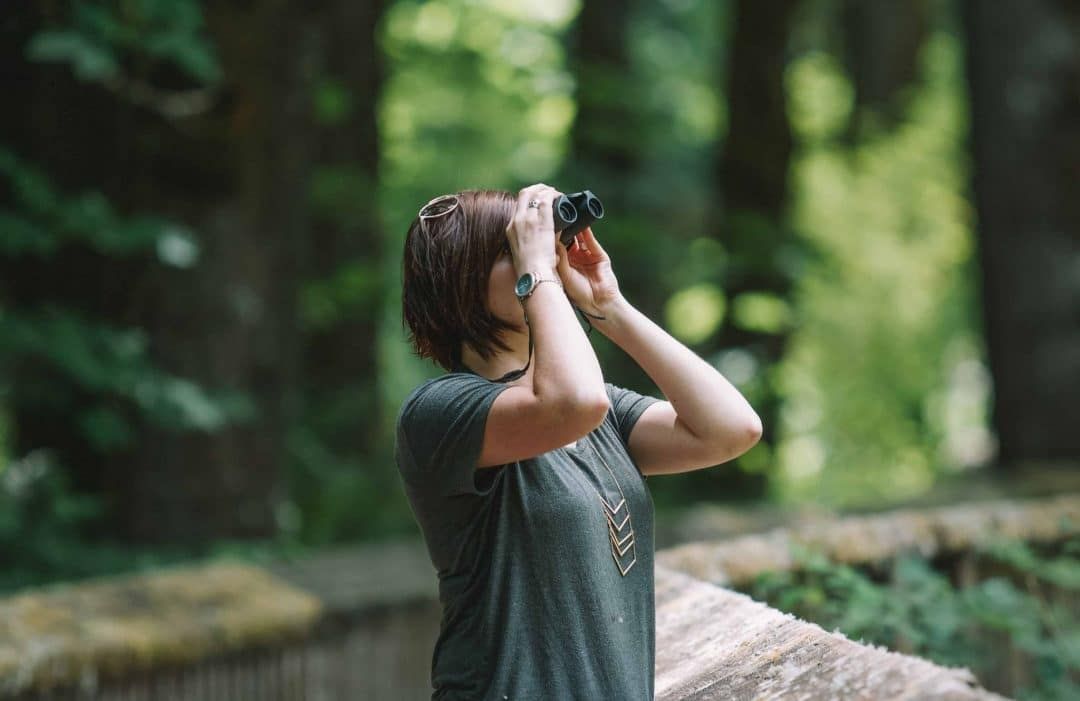
Once you get used to having a pair of binoculars at hand, it’s hard to go without them.
And with these compact binoculars, you’ll never have to.
The binoculars on this list are lightweight and convenient, with surprisingly good optical quality and plenty of unique features.
Whether you’re looking for high-end binoculars, ultralight trail binoculars, or high-power binoculars for wildlife, we’ve got you covered.
In this article, we’ll discuss binocular sizes and specs, where to buy binoculars, and how to choose the best compact binoculars for you.
We’ve broken them down into the best pick for different uses, so you can find the best pair of binoculars that’s perfect for your favorite outdoor activities.
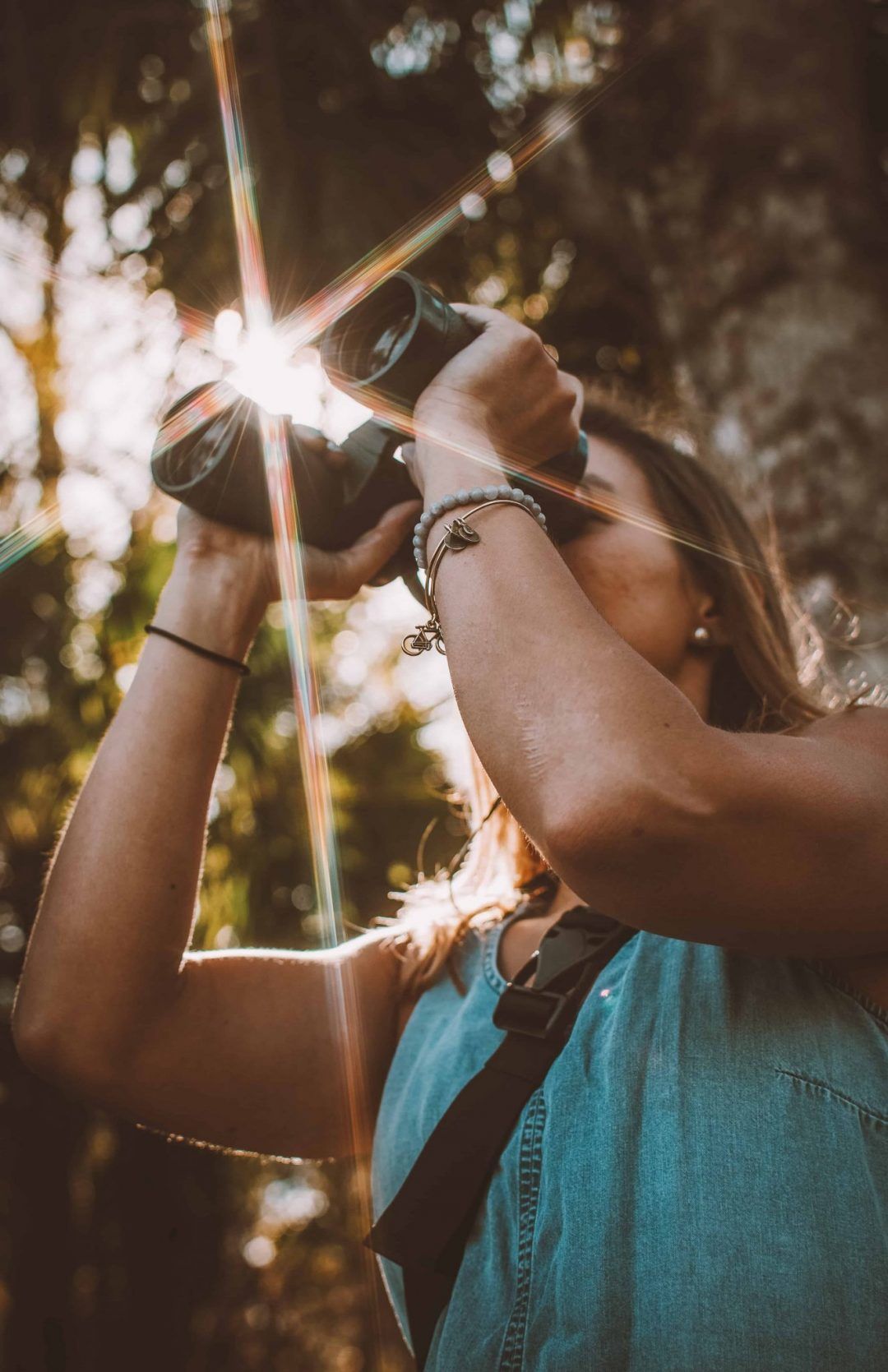
Here’s a Quick Look at Our Recommendations
- Best Overall Compact Binoculars – Zeiss Terra
- Best Binoculars for Birding – Vortex Vanquish
- Best Binoculars for Wildlife Viewing – Vortex Diamondback
- Best Binoculars Under $100 – Celestron Outland X
- Best Lightweight Binoculars – Leica Ultravid
- Best Binoculars for Travel – Skygenius
- Best Binoculars for Hiking – Nikon Trailblazer
- Best Binoculars for Paddling – Bushnell H2O Waterproof/Fog Proof Binoculars
- Best Binoculars with Night Vision – JStoon 4K Night Vision Goggles
- Best Binoculars for Kids – Obuby Binoculars for Kids
#1 Zeiss Terra
Best Overall Compact Binoculars
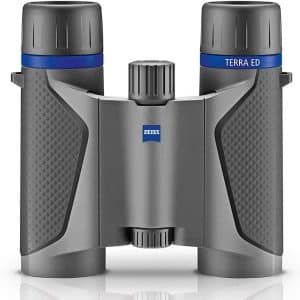
Magnification: 8X
Objective Lens: 25 mm
Prism Type: Roof
Weight: 11 oz
FOV: 375 ft
Eye Relief: 16 mm
Features: Waterproof, hydrophobic multi-coated lenses
These Zeiss Terra pocket binoculars are some of the best compact binoculars on the market.
They’re extremely packable and durable at a great price considering their features.
At 8×25, these aren’t the most high-powered, but they’re some of the best small binoculars on the market.
One of the best features of the Zeiss binoculars is their high image quality with very low chromatic aberration.
As a Zeiss product, they come with high-quality coatings that allow for 88% light transmission.
Zeiss’s reputation for high-quality optics and their two-year warranty make them an excellent all-around choice.
As an alternative, the Celestron 71330 Nature DX binoculars are a better price than the Zeiss Terra.
They also come with extra accessories like a neck strap and lens caps.
With that said, the Zeiss binoculars are smaller and sleeker, so they’re less bulky for travel or hiking.
If you’re looking for the best binoculars under $300, take a look at the Nature DX.
Otherwise, the Zeiss Terra is our pick for the best all-around compact binoculars.
PROS
- Versatile – great for travel, birdwatching, hiking, and general wildlife
- Small and compact – only 4.5 x 4.4 when folded
- Extra-large field of view
- Two-year warranty
- Multicoated
CONS
- Not suitable for marine or astronomy use
- Not fog proof
#2 Vortex Vanquish
Best for Birding
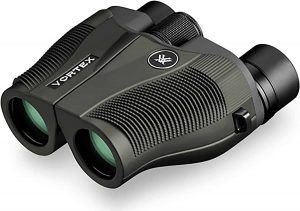
Magnification: 8X
Objective Lens: 26 mm
Prism Type: Reverse Porro
Weight: 12.7 oz
FOV: 352 ft
Eye Relief: 16 mm
Features: Waterproof and fog proof
The Vortex Vanquish are some of the best binoculars for birdwatching because of their optimal lens size and extra features like waterproofing and fog proofing.
At 8×26, they’re strong enough to bring out details but still small enough to fit in your pocket.
These binoculars are especially ideal for their comfort and flexibility.
The eyecups can be adjusted to your preferred distance and the distance between the pupils is also easy to set.
They also have a large center focus wheel and all-around rubber armor that makes them easy to grip.
And the body has a unique molded design.
The Vortex Vanquish binoculars are fully multi-coated with both lens and prism coating, so you can be sure the optics are solid.
The fact that these are waterproof and fog-proof sets them apart from other binoculars for bird watching – the fanciest glass in the world isn’t useful if it’s covered in moisture.
Being able to grab your binoculars and run outside knowing they won’t fog up is essential for birding.
PROS
- Waterproof and fog proof
- Fully multi-coated lenses
- Clad in tough, light aluminum
- Eyecups can be adjusted
- A lot of features for the price
CONS
- Smaller field of view
- Not as sleek as the Zeiss Terra
#3 Vortex Diamondback
Best for Wildlife Viewing
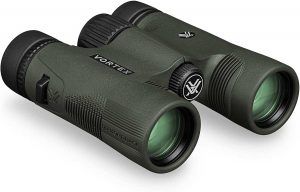
Magnification: 8X
Objective Lens: 28 mm
Prism Type: Roof
Weight: 14 oz
FOV: 332 ft
Eye Relief: 18 mm
Features: Waterproof and fog proof, tripod capable
While these Vortex Diamondback binoculars come at a higher price, the high-end dielectric prism coating makes them worth the splurge.
Like the Vortex Vanquish, they’re made of solid aluminum with a rubber outer wrapping.
They also come fully multi-coated, making them some of the best safari binoculars.
The Diamondbacks are some of the best binoculars for viewing wildlife because vortex optics mean they perform better in low-light conditions.
The wider aperture can gather more light and the dielectric prism coating transmits almost 100% of it to the viewer (more than phase-corrected coating).
This comes in handy at dusk or dawn when animals are most active.
Another good feature of the Diamondbacks is the tripod mounting.
While it’s not necessary to have anything under 10x magnification on a tripod, it’s nice to have the option.
It’s much easier to stake out a bird’s nest or animal den with a tripod set up than it is to hold the binoculars in a single spot for hours.
Another good option for wildlife-viewing binoculars is the Nikon 16001 PROSTAFF 7S binoculars.
They’re almost identical in size, weight, and features to the Vortex Diamondbacks.
However, the Vortex Diamondback binoculars have a little smaller field of view.
Vortex optics are higher quality though—compact Nikon binoculars use lower-end phase-correction prism coating.
Lastly, the Vortex binoculars are at a lower price point compared with the name-brand Nikon.
PROS
- Adjustable eyecups
- Tripod capable
- High-quality dielectric prism coating
CONS
- Smaller field of view than comparable models
- Heavier than the Vanquish
#4 Celestron Outland X
Best Binoculars Under $100
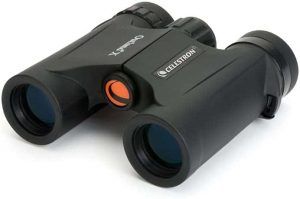
Magnification: 10X
Objective Lens: 25 mm
Prism Type: Porro
Weight: 11.4 oz
FOV: 330 ft
Eye Relief: 25 mm
Features: Waterproof, fog proof, accessories included
These small binoculars might also be some of the best binoculars for the money.
The Celestron Outland X binoculars pack loads of quality features into a tiny, low-price package.
The banner item here is the high-quality BAK 4 glass.
For a compact binocular with a price below $50, optical quality is usually less than perfect.
However, the Outland X binoculars offer quality optics and multi-coating lenses.
In addition, they’re waterproof and fog proof.
So what does the Outland give up to maintain its $50 price?
Focus distance, eye relief, and full multi-coating are some of the top features this compact binocular is missing.
First, the close focus distance is almost 20 feet.
While it might not seem like a lot, that severely limits the usable range of your binoculars.
For example, if the bird you’re trying to view flies closer to you, you would actually have to back up to see it clearly.
If you’re planning to view wildlife, a wider range is helpful.
The eye relief of 10 mm and an exit pupil diameter of 2.5 are also just within the minimum advisable dimensions.
With its small exit pupil and narrow lenses, this binocular would underperform in low light conditions.
That said, this binocular is still a solid choice if you’re looking for a quality pair of budget binoculars.
The Celestron Outland X is easily one of the best binoculars for under $100 and the best cheap binoculars all around.
PROS
- Lifetime warranty
- US-based technical support to help you get the most out of your purchase
- BAK 4 glass
CONS
- Low eye relief – tight for someone with glasses
- Not tripod adaptable
#5 Leica Ultravid
Best Lightweight Binoculars
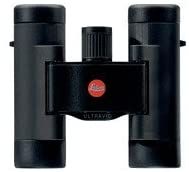
Magnification: 8X
Objective Lens: 20 mm
Prism Type: Roof
Weight: 8.5 oz
FOV: 307 ft
Eye Relief: 15 mm
Features: Phase-correcting prism coating, weather-resistant
If you’re looking for the best small binoculars (and price isn’t an issue), the Leica Ultravid is an obvious choice.
These are some of the smallest binoculars on the market at just 4.4 x 3.7 x 1.5 inches.
They weigh just half a pound and can easily be stored in a glove box or pocket for quick use.
And these mini binoculars pack a serious punch in terms of image.
Leica is one of the best brands of binoculars out there, so you can be sure you’re getting the absolute best optics.
They offer an incredibly sharp image and high-end optics.
For their size and weight, they have an excellent field of view at 1,000 yards and a close focusing distance of just 6 ft.
You’d be hard-pressed to find another set of pocket binoculars that cover so many bases.
The only downside with these binoculars might be their durability.
With a lack of waterproofing, they probably wouldn’t be the best binoculars for travel or hiking.
And given the price, you might be reluctant to take these ultra-fancy ED glass binoculars on more adventurous outdoor activities.
PROS
- Incredibly tiny
- Beautiful, high-contrast image
- Superior ED glass and overall premium optics
CONS
- Not fully waterproof or fog proof
- Doesn’t come with objective lens caps
#6 Skygenius
Best for Travel
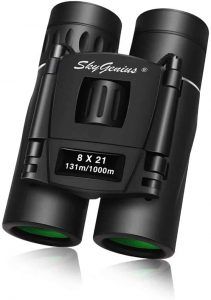
Magnification: 8X
Objective Lens: 21 mm
Prism Type: Roof
Weight: 6 oz
FOV: 369 ft
Eye Relief: 16 mm
Features: 12-month warranty, easy focus wheel
The Skygenius binoculars are some of the best travel binoculars because they’re affordable, versatile, and easy to use.
While they’re not the highest-powered binoculars, this little pair could easily take you (and your family) through a whole trip.
They’re the perfect size to throw in your pocket and pull out at a concert, the theater, or on a hiking trip.
They even come with a convenient neck strap to make them easy to carry and use when doing any of these activities.
And given their low weight and price, they wouldn’t be too stressful to travel with.
This also makes them great for kids – especially since the focus wheel is exceptionally easy to use.
Lastly, for cheap and simple binoculars, the Skygenius binoculars offer surprisingly good optics.
The prism is made of BK7 glass and they come fully coated with multilayer broadband green film, which increases contrast.
They also offer a wide field of view given the magnification and lens diameter.
This means they would make a great pair of budget binoculars for bird watching.
PROS
- Versatile and compact
- Great optics for the price
- Broadband green film coating for increased contrast
- Some of the lightest binoculars on this list
- Easy to focus
CONS
- Small exit pupil and aperture diameter means they’re not the best in low light
#7 Nikon Trailblazer
Best for Hiking
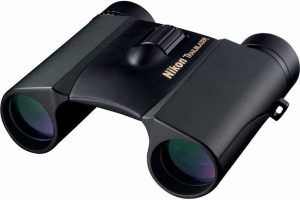
Magnification: 8X
Objective Lens: 25 mm
Prism Type: Roof
Weight: 10 oz
FOV: 429 ft
Eye Relief: 10 mm
Features: Waterproof and fog proof
If you’re looking for the best hiking binoculars, you’ll need something that’s tough and versatile to take you through varied terrain and conditions.
And the Nikon Trailblazers are just that.
These binoculars are fully waterproof and fog proof with rugged rubber armor and a non-slip grip.
The solid construction and weatherproofing make the Nikon Trailblazer some of the best backpacking binoculars.
However, it’s the multi-coated optics and exceptional field of view that really set them apart.
They come with fully multi-coated lenses and a BAK 4 high index prism inside.
Even better, their field of view is just under 430 feet at 1,000 yards.
This makes them ideal for scanning a landscape or keeping an eye on wildlife at a distance.
Given their moderate magnification and wide field of view, the Nikon Trailblazer binoculars would also be ideal binoculars for whale watching.
PROS
- Lead and arsenic-free eco glass – no pollution if they get broken outside
- Exceptional field of view
- Compact and lightweight
CONS
- 10 mm eye relief is tight if you wear glasses
#8 Bushnell H2O Waterproof/Fog Proof Binoculars
Best for Paddling
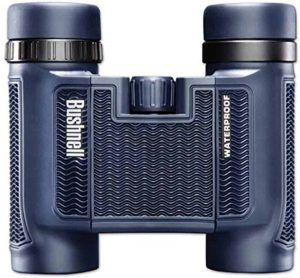
Magnification: 8X
Objective Lens: 25 mm
Prism Type: Roof
Weight: 10 oz
FOV: 360 ft
Eye Relief: 12 mm
Features: Fully waterproof and fog proof
The Bushnell H2O are some of the best budget binoculars with waterproof features.
They’re fully sealed with O rings and nitrogen purged to make them fog proof.
While these are common features on waterproof binoculars, this pair comes with a soft texture grip that makes them easy to hold even when wet.
The non-slip rubber armor makes these folding binoculars perfect for paddling or fishing.
While they don’t have the best optical quality, they do feature a BAK 4 prism which is great for the price.
One downside to the Bushnell H2O is the 12 mm eye relief.
The adjustable eyecups are enough for most people who wear glasses, but it might not be totally comfortable.
The close focus distance could also be an issue.
At 15 feet, it’s possible your subject could move out of the focus area.
If you plan to use these paddling on a river or the ocean, you’ll likely always be far enough from your subjects, but it’s something to keep in mind.
PROS
- Nonslip grip and rubberized exterior
- Compact folding design
- Excellent price
CONS
- Minimal eye relief
- 15-foot close focus distance
#9 JStoon 4K Night Vision Goggles
Best Binoculars with Night Vision
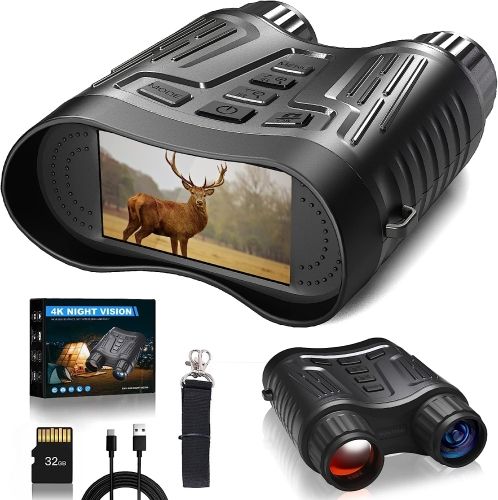
Magnification: 10X optical zoom, 8X digital zoom
Objective Lens: NA
Prism Type: Digital CMOS sensor
Weight: 40 oz
Features: Night vision up to 980 ft, weather-resistant
If you’re looking for the coolest binoculars on this list, look no further than the JStoon 4K Rechargeable Night Vision Goggles.
Compact binoculars with low-light-level Night Vision used to be something only military and security professionals could get their hands on.
Now, there’s a compact binocular with night vision capabilities that costs about the same as a mid-level birding binocular.
The JStoon Night Vision goggles are a unique product with both optical and digital zoom and a built-in photo/video camera.
The integrated camera takes 36MP pictures and 4K video.
And they allow you to see almost 1,000 ft in complete darkness.
Plus, they have a six-hour battery life and you can fast-charge them in the field with a phone power bank, so you can use them all night.
These binoculars won’t satisfy every need, but they would be amazing for nighttime bird watching.
They would also make a great gift for someone who already has an arsenal of standard binoculars.
PROS
- Can see what standard binoculars can’t in the dark
- Integrated camera for pictures and video
- Tripod mountable
- Great price for the performance
CONS
- Digital zoom means lower image quality than standard binoculars during the day
#10 Obuby Binoculars for Kids
Best for Kids
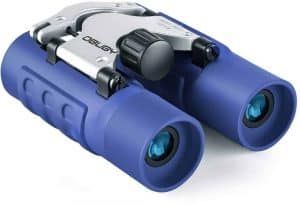
Magnification: 8X
Objective Lens: 21 mm
Prism Type: Roof
FOV: 400 ft
Features: Lightweight, easy to grip, comes in multiple colors
These Obuby binoculars are shockproof, waterproof, and come in a range of fun colors making them one of the top-rated binoculars for kids.
Solid image quality means they’re one of the best affordable binoculars all around (whether you’re a kid or not).
While they’re fun and cheap, these binoculars actually feature some decent optics.
They come with BAK 4 roof prisms, full green broadband multi-coating, and a 400-foot wide field of view.
The wide field of view is especially helpful for children.
It makes it much easier to find their subject in the landscape or follow a moving animal.
And at about $20, they’re the best-priced binoculars on this list.
They also come in more than a dozen colors, so you can avoid fights and get a different color for every kid.
These could even make a good set of pocket binoculars for both kids and adults.
The eyepieces can be expanded to fit anyone, allowing an adult to quickly look through the binocular to focus it, then adjust it back so the child can use it.
PROS
- Fully rubberized and shockproof
- Soft rubber eyecups for safety
- 400-foot field of view is excellent for any binocular of this size and magnification, let alone a children’s model
CONS
- Lower quality optics than adult-specific binoculars
Are Compact Binoculars Any Good?
The answer today is an emphatic yes.
Some of the best binoculars on the market are compact.
Advances in extra-low dispersion glass and prism technology mean that it’s possible for a compact binocular to produce similar image quality as some full-size binoculars.
Small binoculars typically use a roof prism system, which we’ll dive into below.
You’ll likely have to pay a higher price for compact binoculars with similar performance to a midsize model, because of the engineering challenges inherent in roof prism binoculars.
That said, the costs are worth it.
Larger models might offer better optics or fancy features, but their size and weight mean they’re less fun (or downright impossible) to bring with you.
Choosing a compact model will ensure you can take your binoculars with you no matter where your outdoor adventures take you.
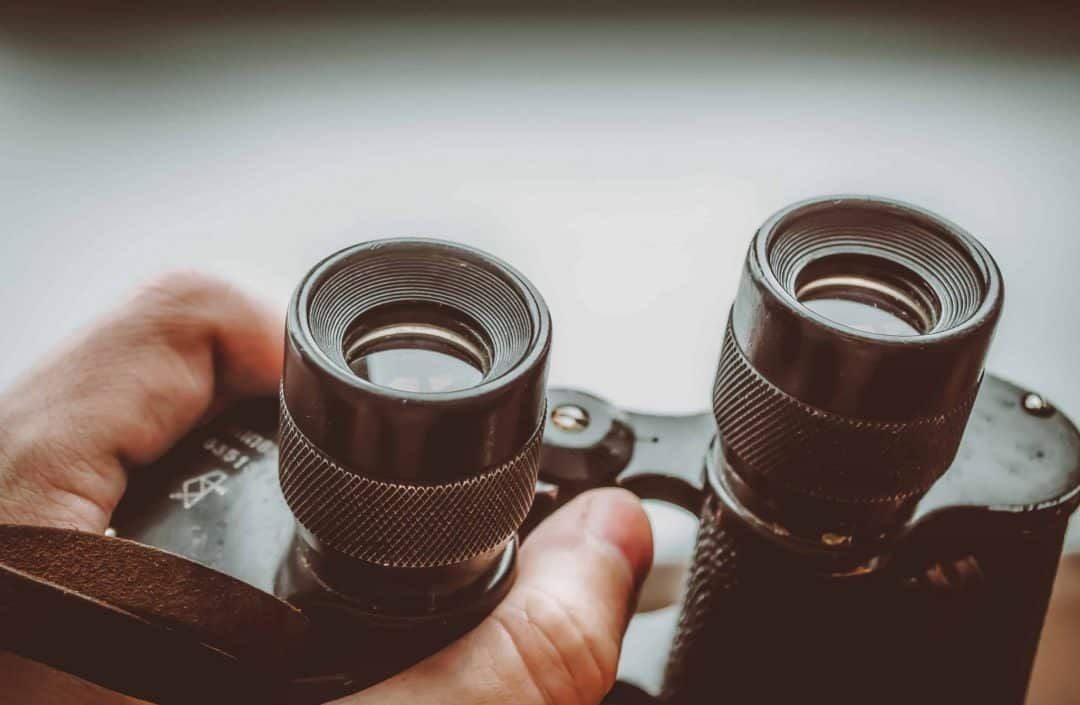
What Can You Use Compact Binoculars For?
A compact binocular is ideal for any situation where size and weight are important – namely hiking, backpacking, birdwatching, paddling, or travel.
Lightweight and compact binoculars are also more comfortable for long periods of time.
Larger binoculars can get heavy after a while, especially if you’re lifting them up to your eyes all day.
They might not seem heavy at first, but a binocular that weighs more than a pound or two will likely feel very heavy at the end of the day.
For this reason, people often use a tripod with the largest models.
In comparison, most of the compact binoculars on this list weigh less than a pound and are comfortable to use for long periods without a tripod.
Consider a compact binocular if you want something easy to use or don’t want to worry about bringing a tripod.
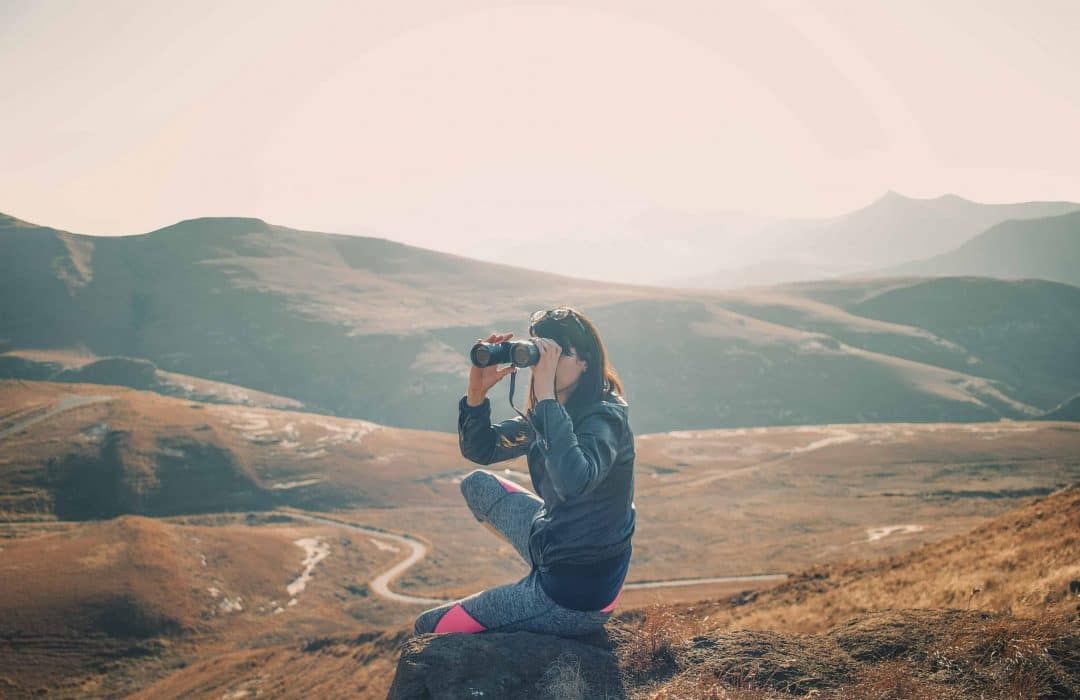
What are the Pros and Cons of Using Compact Binoculars vs Full-Sized Binoculars?
The obvious advantage of compact binoculars is their size.
They’re small, light, and great for any time portability.
But in exchange for that convenient size, compact binoculars sacrifice light-gathering abilities.
The smaller the lens, the less light it will take in, which means reduced performance in low-light conditions.
Compact binoculars are usually perfectly fine in broad daylight, but larger binoculars will produce a brighter view in low-light situations, such as dusk, dawn, or nighttime.
Mid-size binoculars are a good compromise between compact and full-size binoculars because they typically offer better light transmission.
And they’re still comfortable to use for long periods.
They’re usually portable but not small enough to stuff in a pocket.
Full-sized binoculars are the most powerful and strongest binoculars.
However, they’re often too large and heavy to throw in a pack or hold up for extended periods.
Types of Compact Binoculars
Roof Prism vs Porro Prism Binoculars
The “classic” image that comes to mind when you think of binoculars is the Porro prism design.
This prism type (called the form factor) uses mirrors to bounce the light in a z pattern back to the eyepiece.
While they’re less compact, Porro prism binoculars have advantages in terms of image quality.
Because of the z shape, there’s a shorter distance between the lens and eyepiece, which gives them a greater depth of field.
Depth of field refers to the amount of area that’s in focus.
A smaller depth of field means more blur outside of the center focus area and a flatter, less 3D-looking image.
Whereas a greater depth of field produces a more crisp, natural-looking image.
It’s also easier to increase lens diameter with offset objective lenses.
Roof prism design differs from Porro in that the image travels in a straight line back to the eyepiece.
This form factor gives the binocular a uniform shape that’s easier to hold, fold, and store.
Optical quality varies widely between these two types of binoculars – one isn’t necessarily better than the other.
However, compact roof prism binoculars are more difficult to engineer and generally more expensive.
If the size isn’t a concern, you’ll likely find better optics on Porro prism binoculars vs roof prisms at the same price point.
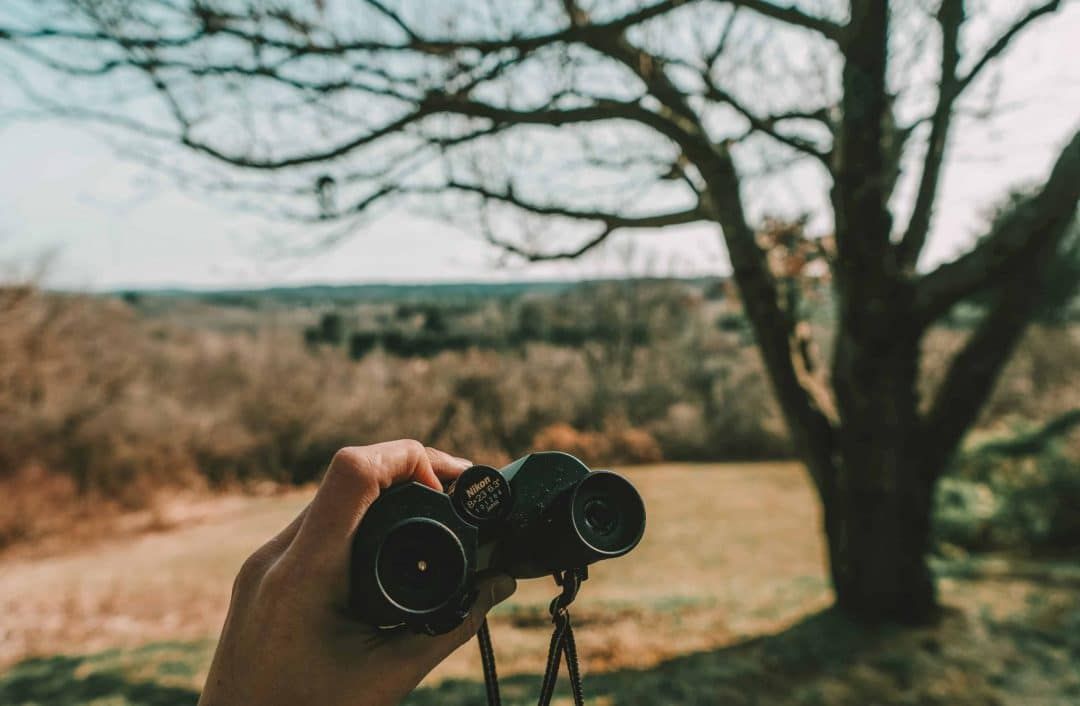
Birding Binoculars
Compact binoculars make some of the best bird binoculars because they’re easy to use to quickly focus.
A magnification factor of 7X to 10X is best for birdwatching, with 7X-8X being the most common.
This is a sweet spot in terms of magnification in binoculars – plenty of detail without the difficulties that come with more magnification (which we’ll discuss below).
Fog-proof binoculars that remain clear going from warm to cool temps (hopping in and out of a car, for example) and which are easy to focus, are usually the best binoculars for birdwatchers.
Wildlife Viewing Binoculars
Binoculars that are fully waterproof with rubber armor are a good choice for wildlife viewing.
This is especially important if you’re going to be using your binoculars in places with a lot of water and mud.
One thing to keep in mind is that the best safari binoculars aren’t always the most powerful binoculars.
Lower magnification of 7X or 8X will keep the image steady in an unstable environment, like a boat or off-road vehicle.
Hiking/Backpacking Binoculars
Hiking and backpacking binoculars have to be small enough to throw in a pack, so roof prisms are usually used here.
There are a lot of small powerful binoculars on the market that would be perfect for an extended hiking trip.
A pair that folds small and weighs about a pound or less will make for the best backpacking binoculars.
Travel Binoculars
Lightweight binoculars also make great travel binoculars.
A versatile pair with midrange zoom and midsize lenses is good for most travel situations.
It’s best if travel binoculars can fold up and be stored in a pocket for easy carrying.
Nowadays, you can sometimes find a camera in binoculars, which might be helpful for sightseeing or safaris when you don’t want to carry two devices.
Paddling Binoculars
If you’re going to be taking them in the water, binoculars that are fully waterproof are a must.
Paddling binoculars typically have O-rings to seal out moisture and can survive being dunked in a lake or river.
Water-resistant binoculars will be fine in light rain, but wouldn’t be the best choice to take out on a boat.
You should keep these same considerations in mind if you’re looking for good binoculars for whale watching and go for the fully waterproof option.
Night Vision Binoculars
Night vision binoculars use infrared or thermal imaging technology to augment their optics.
If you’re buying night vision binoculars, you’re likely using them for precision viewing like nighttime bird watching, so the range is an important consideration.
More high-end night vision binoculars can see objects at least 100 feet away and often much further.
Look for a pair with the highest resolution and a range that fits with your activities.
A Quick Guide to Binocular Sizing
If you’re wondering how binoculars are rated, don’t worry.
It’s more simple than it looks.
Binoculars are rated by their magnification x aperture (the diameter of their lenses).
There are three main size categories of binoculars: compact, mid-size, and full-size.
Binoculars are classed by the diameter of their objective lenses (the two lenses at the end of the binocular and the ones closest to your subject).
Compact binoculars have an objective lens measuring 30 mm or less.
The next size up is mid-size binoculars, which have objective lenses between 30 and 40 mm wide (this is the most common type).
Full-size binoculars have an objective lens diameter of greater than 40 mm.
These are the largest and most powerful binoculars.
The size of the objective lens affects how much light a binocular can take in and how wide its field of view is.
A wider objective lens receives more light (better in the dark) and has a wider field of view.
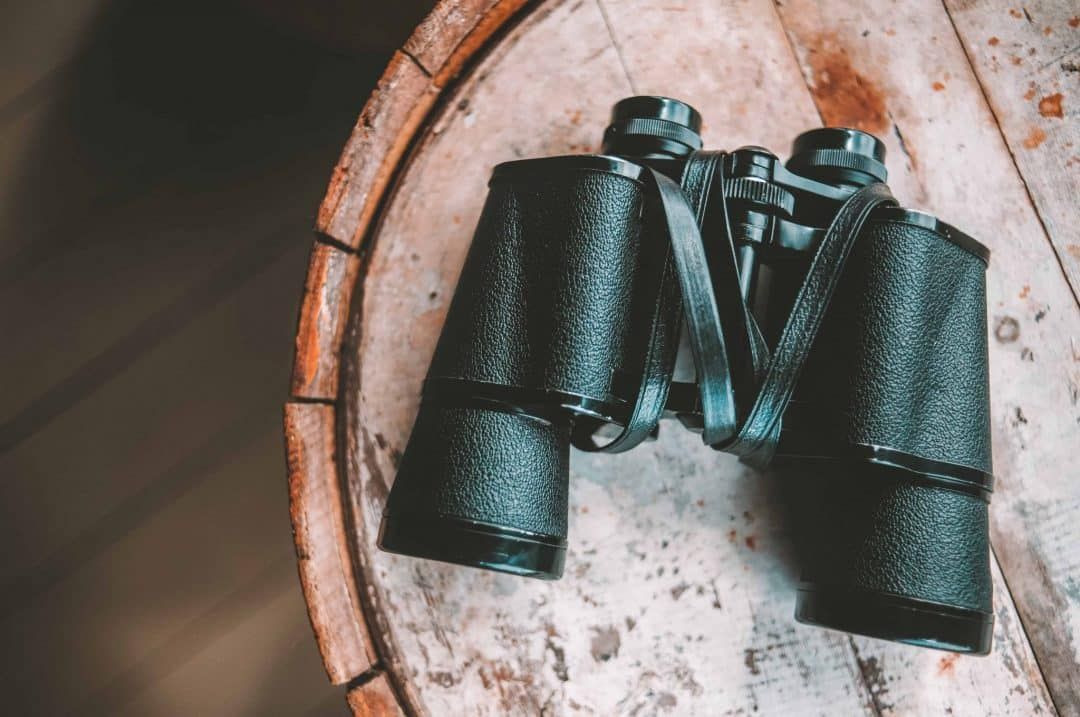
What is the Best Magnification for Binoculars?
For compact binoculars, you should look for a magnification between 7X and 10X.
While it might seem like more is always better, higher magnification means there’s less total area captured in the eyepiece (the field of view).
A wider field of view makes it easier to spot wildlife and follow subjects as they move.
It also produces a more stable image.
What Should I Look for in Compact Binoculars?
Size & Weight
Pick a size and weight that makes sense for your activity.
If you’re going on short nature walks looking for birds, a heavier pair of binoculars with multi-coated optics is a good choice.
For backpacking, you’ll want to look for a pair that weighs less than a pound, preferably half a pound.
Whichever binoculars you get, make sure they fit with how you’ll be carrying them (e.g. if you want pocket binoculars, make sure they actually fit in your pocket).
Other important size considerations are the eye relief and exit pupil.
Eye relief is the distance from the eyepiece to your eye.
Long eye relief is important for people with glasses.
Otherwise, you won’t be able to look through the binoculars properly.
10 or 11 mm is usually the minimum.
The exit pupil is the apparent size of the image in the eyepiece (or the size of the space where light can pass out of the lens).
A larger exit pupil will take up more or your vision and give you a wider view.
Look for one that’s at least 2mm in diameter, but more is better.
The exit pupil size also determines how bright an image is to the viewer.
Bigger exit pupils are best for low light conditions and they’re generally indicative of a better quality binocular.
This spec is also affected by adjusting the binocular settings, so make sure you check both the maximum and minimum exit pupil diameter before buying.
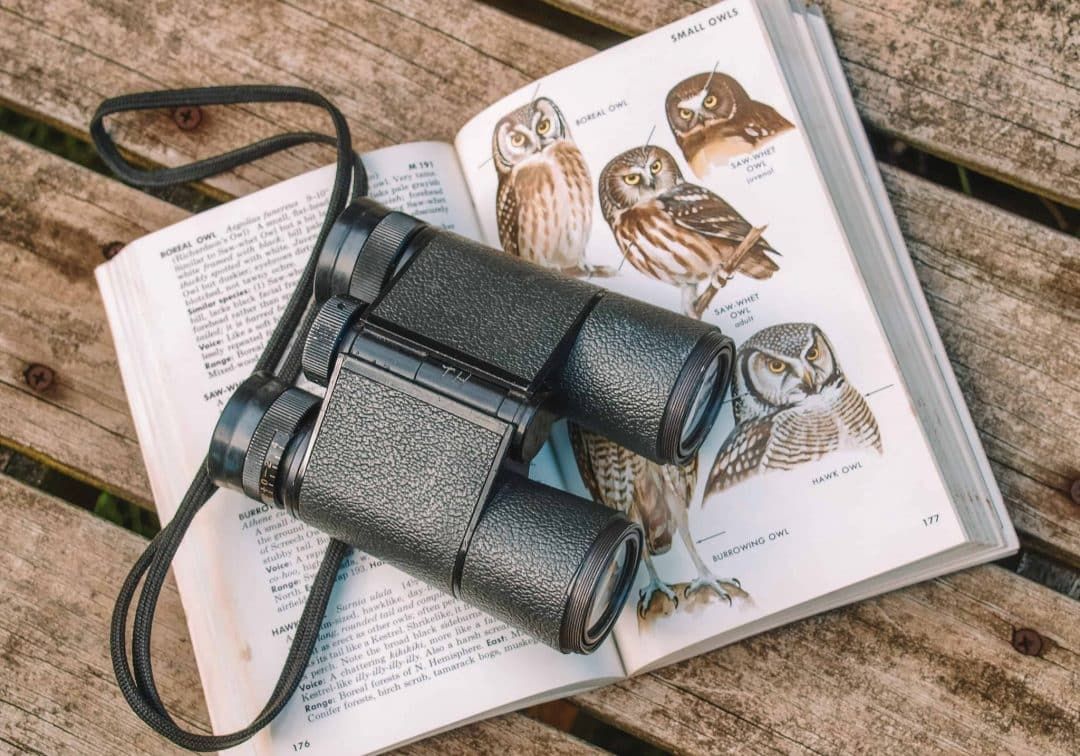
Body Construction
Comfort and durability are especially important with compact binoculars.
This is because you’re likely going to be using them in more technical settings (hiking, whale watching, etc).
Look for binoculars that are waterproof and have rubber armor and a non-slip grip.
Most compact binoculars are made out of aluminum, which is a sturdy, lightweight material.
Take note if a binocular uses plastic body construction since it probably won’t be as light.
Field of View
The field of view is the total area that’s viewable in the eyepiece.
A larger field of view is generally better since it makes it easier to spot and follow your subjects.
The field of view is measured by the size of the image that’s captured by a binocular at 1,000 yards.
Be aware that the field of view can vary widely between different binoculars, even if they have the exact same specs.
Three pairs of 8×30 binoculars can all capture a different field of view depending on their form factor and optics.
The magnification and objective lens diameter (or aperture) affect the field of view, with magnification being the most important factor.
High magnification means a narrower view.
Aperture
Aperture is the diameter of a binocular’s objective lenses (the ones closest to the subject – the lenses closest to your eyes are called the ocular lenses).
A larger diameter aperture doesn’t increase the magnification, but it can take in more light.
This produces a brighter picture in low-light conditions.
Larger apertures are necessary for viewing subjects in dim light, such as when you’re stargazing or bird-watching at dusk.
Magnification
Magnification is the amount a subject’s size is increased in the field of view.
So, a subject that’s viewed with 8X binoculars would appear 8 times larger.
Higher magnification produces more detailed images, but these binoculars have a smaller field of view and are more difficult to use.
Anything with 10X magnification or more can be hard to hold and make the view shaky without a tripod.
Above this magnification factor, consider spotting scopes with a tripod instead of hand-held binoculars.
Lens Size
The binocular lens size is magnification x aperture.
The most common size is 8×42, but for compact binoculars look for a lens that measures 30 mm in diameter or less.
Lens Glass
Glass is the single most important feature in determining the price and quality of your binoculars.
Like camera lenses, binocular lenses are complicated, precision-engineered items and high-quality ones can cost more than a car.
The best lenses are typically made with BAK 4 or Barium Crown glass, which is superior because it transmits nearly all the light it receives.
BAK 4 has a high reflective index and very few imperfections (like bubbles trapped in the glass from manufacturing, which increase internal reflection).
BK7 glass is more common and has more imperfections than BAK 4, but it’s still high-quality optical glass.
You can tell whether a pair of binoculars uses BK7 or BAK 4 glass by checking the exit pupil.
This is the small hole inside the lens where the image can be seen.
BK7 prisms have a squared-off hole, while BAK 4 prisms use a round hole.
SK15 glass is less common than BAK 4 or BK7, and its performance falls somewhere in between the two.
It transmits light better than BK7 but has more internal reflection than BAK 4.
High-quality lenses are often rated as low-dispersion or extra-low-dispersion glass, also called ED glass.
This means they’re engineered to transmit light with almost no distortion.
They usually have the highest quality coated optics and show less chromatic aberration.
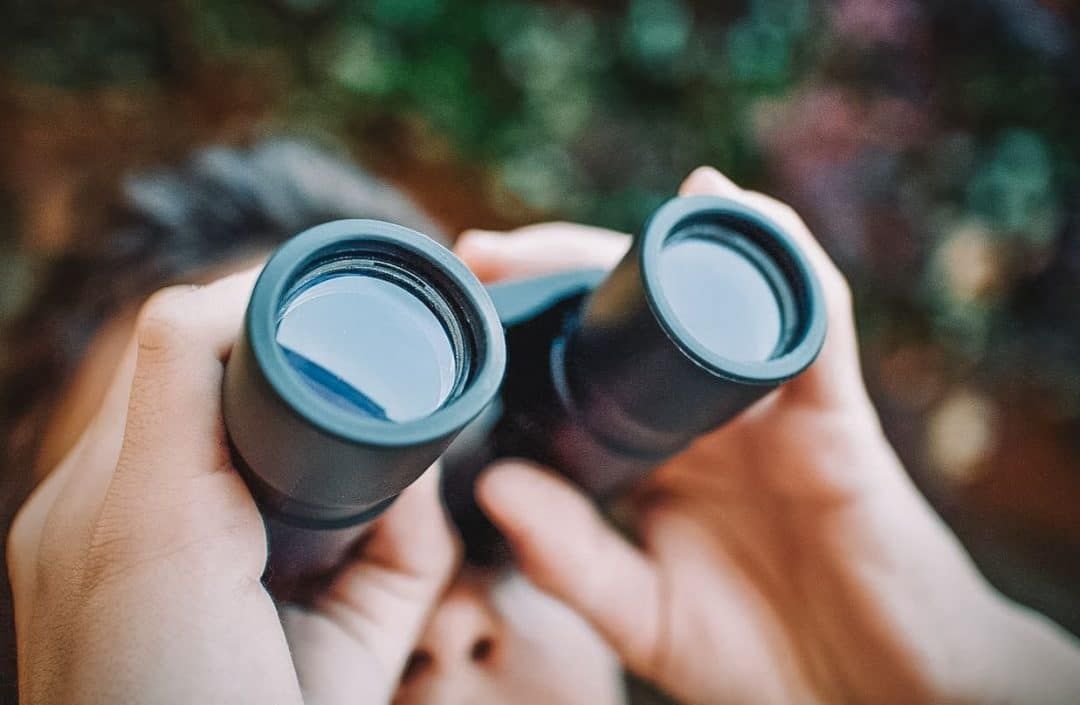
Lens Coating
Anti-reflective coatings and films are another major difference between cheap binoculars and quality models.
Coated optics help reduce glare and increase light transmission through the surfaces where light meets air.
They can also improve contrast and make colors more vivid.
A coated lens is one that has been treated on at least one surface.
Multi-coated means the lens has multiple surfaces coated or multiple layers of coating.
A fully multi-coated lens has been coated multiple times on every surface, inside and out.
The highest quality is broadband fully multicoated, which is designed to provide increased light transmission across a wider spectrum of light wavelengths.
In addition to lens coatings, there are prism coatings.
The best of these are dielectric coatings, which can transmit almost all the light that strikes the prism.
Phase-corrected prism coatings are more common and still very useful.
Prism Types
Prisms come in two main types, Porro (traditional) and roof prism design, as discussed above.
Most compact modern binoculars have roof prisms, which makes them much less bulky.
Within roof prisms, there are different types.
The most common is the original Abbe-Koenig prism, but there are others like the Schmidt-Pechan prism with their own advantages.
SP prisms (commonly used by Zeiss) have thinner optical tubes, so they can be even smaller and easier to hold.
Waterproof & Fog proof
A waterproof lens will have barrels that are completely sealed off with O-rings to make them watertight.
This doesn’t mean they’re indestructible – every manufacturer will rate their waterproofing differently (usually by depth and duration they can be submerged).
And a waterproof binocular can still fog up due to temperature changes.
Fog-proof binoculars avoid this by removing the air from inside the barrel and replacing it with nitrogen (or sometimes another gas), which has no moisture.
These are a great choice for the outdoors because they’ll be usable in all conditions.
Eye Relief
Eye relief is the distance you need from the eye to the eyepiece to see an image clearly.
This is most important if you wear glasses – look for eye relief of at least 10 or 11 mm to give adequate room for your glasses.
Stability
Image stability is affected by your binoculars’ magnification – high magnification amplifies hand movements and makes it harder to get a stable image.
If stability is an issue, consider a tripod or binoculars with image stabilization features.
Other Features
Good close focus is another important feature of quality binoculars.
This spec measures how close you can get to your subject and still be able to focus.
Anything below 6.5 is usually considered good.
Close focus is less important if you’re buying binoculars for the theater, concerts, or some other venue where you’re sure your subjects will be far away.
Diopter adjustment is also handy.
This is a feature that allows you to fine-tune your binocular focus to your own vision, so you don’t have to use your glasses.
It’s especially ideal for outdoor situations like hiking where you might be without your glasses.
How Much Should I Plan to Spend on a Quality Pair of Compact Binoculars?
A good set of compact binoculars isn’t cheap.
High-end models like the Leica and Swarovski CL start at over $600 and can run into the thousands.
The good news is that there are a lot of mid-range choices among the 10 best compact binoculars. These are priced around $100 – $300, like the Nikon Trailblazer, Nature DX, Safari Ultrasharp, and Vortex Optics offerings.
They might not have the highest image quality, but they’ll certainly get the job done.
If you want something for casual on hikes, paddling, and other outdoor use, take a look at one of these mid-range binoculars.
You certainly wouldn’t want to drop your high-powered HD binoculars in a river.
If you find your cheap compact binoculars get a lot of use, you can upgrade with a better understanding of the features and magnification you want.
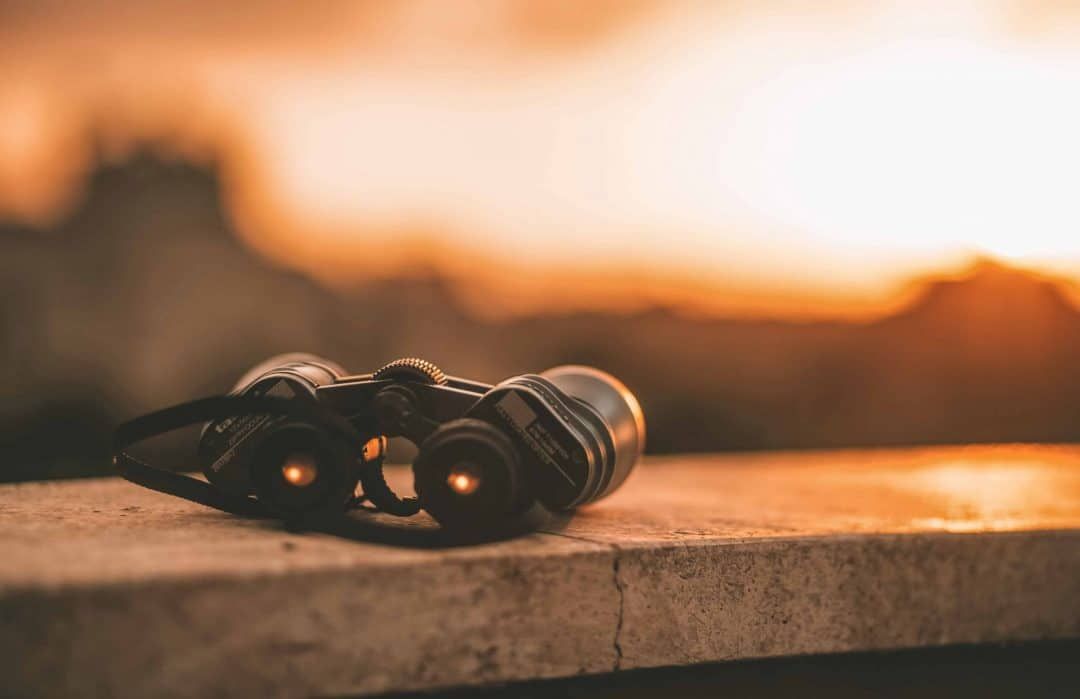
Conclusion – What are the Best Compact Binoculars for the Money?
For a perfect mix of quality and price, the Zeiss Terra Ed Compact Pocket Binoculars are a great choice.
They have high-end Zeiss optics and coatings, extra-low dispersion glass, and all the right features to make them the best compact binoculars for the outdoors.
In addition to this, they’re compact and light enough to take anywhere.
If you’re not comfortable throwing a $1,000 binocular in your glovebox or taking it on the trail, the Zeiss Terra can offer similar image quality to those high-powered binoculars without the price.
The Vortex Vanquish is another great option for the money, especially if you’re mostly going to be using your compact binoculars for birding.
They have quality vortex optics protected by water and fog proofing and good midrange specs.
The Vortex Vanquish can’t compete with the Zeiss for image quality, but they’re great for $100 and will likely do the job for a beginner birder or wildlife enthusiast.
About the Author
Kristi Allen
Kristi Allen is a freelance journalist and travel writer from the US specializing in all things outdoors. She grew up hiking and backcountry skiing in the North East and has driven 15,000 miles across the US and Canada in an ongoing quest to visit every national park. Kristi covered politics before moving abroad and lived in Peru, Italy, and China. She is currently exploring the US by van with plans to return to Asia in 2021.
Looking for more posts on the best outdoor gear? Check out these related posts below!
Best Handheld GPS Device for Hiking
Best Heated Gloves for Cold Weather
Best Outdoor Watches for Active People
Best Dog Backpack Carriers for Hiking
11 Best Backpacking Rain Ponchos
Pin this image for future reference

